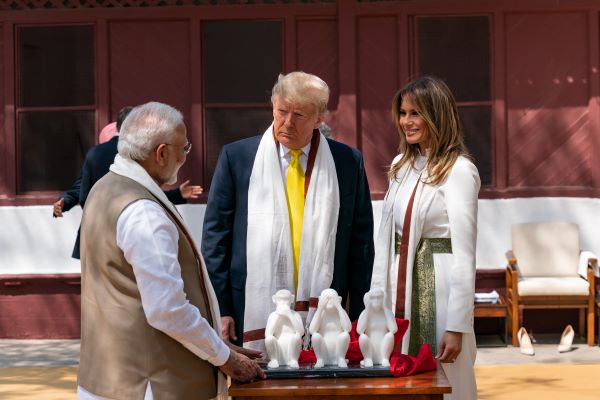.png)
Why Does India Need To Indulge Trump?
Facing Trump’s tariff threats, India treads cautiously between protecting economic interests and avoiding costly confrontation.

April 22, 2025 at 8:00 AM IST
In early April, with the clock ticking on the imposition of “reciprocal tariffs" announced by the US President Donald Trump, an unusual calm cloaked Raisina Hill. While Washington buzzed with Trump’s trademark belligerence, New Delhi chose silence. The Indian government was keeping its cards close to its chest.
Behind closed doors, ministers and industry representatives gathered. Phones were switched off, with clear instructions that India’s stance would not be announced over the loudspeakers. There would be no bravado, no sharp riposte.
At the same time, China was firing back. Even as Trump crudely claimed that trade partners were “kissing his ass,” China matched the US’s reciprocal tariffs step for step. Critics were questioning India’s silence as a sign of defeat and subservience to the US.
At the eleventh hour, most countries were spared as Trump announced a 90-day pause. China, however, has been subjected to 145% tariffs, with a potential of up to a 245% rate.
In Delhi, the mood shifted. Quiet relief replaced speculation about retaliatory strikes. The verdict was clear: any chest-thumping or false bravado could have put India on the back foot.
The Big Fish
India’s quiet diplomacy was not rooted in weakness, but in cold economic logic. The rationale for India’s restraint was simple. It lay in the numbers. The economic engagement with most major trading partners—China, Russia and West Asia—were skewed against India. India’s trade deficit touched an all-time high of $282.82 billion in 2024–25, with China accounting for over a third of it– India’s trade deficit with China was $99.2 billion in 2024-25, the highest ever with any country in a single year.
But with the US, the situation is very different. The US is India’s biggest trading partner with which India runs a trade surplus - India had a trade surplus of $41.18 billion with the US in 2024–25. The US accounted for nearly a fifth of India’s exports, but just 6.3% of its total imports.
This asymmetry is valuable. India’s solar equipment exports are primarily US-facing. Pharmaceutical companies rely on the US not just for volume, but for value as well—over 30% of India’s total pharmaceutical exports go to the US. Moreover, software services and consulting firms get lion’s share of their revenues from the US clients. The numbers speak for themselves: the US is not just a trading partner; it’s the anchor customer.
Diplomatic Tact
The Trump presidency, however, has brought turbulence. His style—volatile, transactional, and ego-driven—poses a dilemma: should India push back or play it safe?
But as reminded at a media briefing by a senior bureaucrat, India was perhaps among the only few countries Washington had sent a team to begin deal negotiations with before it announced unilateral tariffs on trading partners. That in itself is telling. Behind the rhetoric, the US engaged with India. That is leverage, not weakness.
For all the posturing, trade is not conducted on Twitter. Governments change. Interests remain and relationships outlast administrations. Trump may be a loose cannon, but abandoning India’s largest overseas market because of ego would be self-defeating.
As one of the most overused clichés in diplomacy goes: there are no permanent friends or enemies, only permanent interests.
India’s restraint is more about strategy than fear. India has too much to lose in risking a rupture with the US. Unlike China, India lacks the domestic consumption or manufacturing heft to retaliate without self-harm.
As the global order reshapes—with China’s assertiveness rising and multilateralism fragmenting—India will need its key partners more. The US, for all its unpredictability, remains indispensable. As Trump’s tariff pause proves, patience pays. The alternative—rash defiance—would be shooting at one’s own feet. Measured diplomacy remains India’s best tool in navigating the global volatility.




